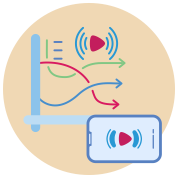
One of the standout features of YouTube is its video format, which allows you to bring your scientific illustrations to life. Through video content, you can create captivating visual experiences by combining your artwork with narration, music, animations, or even demonstrations of your creative process.
This dynamic combination helps convey complex scientific concepts in an engaging and accessible manner, making it easier for viewers to understand and appreciate your illustrations.
YouTube's vast and diverse audience
With billions of active users, YouTube provides a platform to reach a global audience, regardless of their geographic location. By sharing your scientific illustrations on YouTube, you can connect with people from different backgrounds, ages, and areas of interest who share a curiosity for science. This exposure not only enhances your visibility as a scientific illustrator but also fosters opportunities for collaboration, feedback, and knowledge exchange with a diverse community.
Search Features
YouTube's search and discoverability features are crucial for scientific illustrators. By optimizing your video titles, descriptions, and tags with relevant keywords, you can increase the chances of your content appearing in search results related to scientific topics or art-related queries. This helps potential viewers find your videos organically, expanding your reach and attracting a targeted audience who specifically seeks out scientific illustration content.

Engagement
YouTube's engagement features, such as likes, comments, and shares, create an interactive environment for your scientific illustrations. Viewers can provide feedback, ask questions, and share their thoughts, fostering meaningful conversations around your artwork. These engagements not only help you connect with your audience on a deeper level but also provide valuable insights and inspiration for future projects. Embrace the opportunity to engage with your viewers, reply to comments, and build a supportive community around your channel.
Monetization
YouTube's monetization options offer an avenue to generate revenue from your scientific illustration content. Once you meet the platform's eligibility requirements, you can join the YouTube Partner Program and monetize your videos through advertising, channel memberships, or merchandise sales. While monetization should not be the sole focus, it can be a rewarding outcome that supports your artistic endeavors and allows you to invest more time and resources into creating high-quality scientific illustrations.

Educational
The educational potential of YouTube is immense. As a scientific illustrator, you have the opportunity to educate and inspire through your videos. By creating tutorials, explainer videos, or in-depth analyses of scientific topics, you can contribute to science education, making complex concepts more accessible and engaging for viewers. YouTube's platform can serve as a virtual classroom, where your scientific illustrations become powerful educational tools for learners of all ages and backgrounds.
Analytics and Insights
YouTube's analytics and insights provide valuable data about your audience, allowing you to understand their preferences, viewing habits, and demographics. By analyzing these metrics, you can gain insights into which videos perform well, which topics resonate with your audience, and how you can refine your content strategy to better serve your viewers' needs and interests. These data-driven insights empower you to make informed decisions and continuously improve your content.
How to Optimize your YouTube Channel
Optimizing your YouTube channel as a scientific illustrator can greatly enhance your visibility, attract the right audience, and maximize the impact of your content. Here's a guide to help you optimize your YouTube channel effectively:
1. Channel branding:
Create a visually appealing and cohesive brand identity for your channel. Design a captivating channel banner that showcases your unique style and includes relevant scientific elements. Choose a clear and professional profile picture that represents your identity as a scientific illustrator. Consistency in branding helps viewers recognize and remember your channel.

2. Compelling channel trailer:
Craft a short and engaging channel trailer that introduces viewers to your scientific illustrations. Use this opportunity to showcase your best work, provide a glimpse into your creative process, and highlight the educational value of your content. A compelling channel trailer can entice new visitors to subscribe and explore your videos further.
3. Keyword-rich channel description:
Write a keyword-rich channel description that clearly explains what viewers can expect from your content. Include relevant keywords related to scientific illustration, scientific disciplines, and educational aspects. This helps YouTube's algorithm understand the nature of your channel and ensures that your videos are suggested to the right audience.

4. Video optimization:
Pay attention to video optimization for each upload. Use descriptive and keyword-rich titles that accurately reflect the content of your video. Craft compelling and concise video descriptions that provide additional context and include relevant keywords. Add tags that are specific to the scientific subjects, techniques, or themes covered in your video. This optimization helps YouTube recommend your videos to interested viewers.
5. Captivating thumbnails:
Create visually appealing thumbnails for your videos that catch viewers' attention and accurately represent the content. Use high-quality images from your scientific illustrations, add text overlays with bold titles, and incorporate vibrant colors. Thumbnails that stand out amidst the sea of content on YouTube can significantly improve click-through rates and attract more viewers.
6. Playlists and organization:
Organize your videos into playlists based on different themes, scientific disciplines, or tutorial series. Playlists make it easier for viewers to navigate your content and find videos that interest them. This organizational structure also helps YouTube understand the relevancy of your videos, leading to more accurate suggestions and recommendations.
7. Engage with your audience:
Actively engage with your viewers by responding to comments, answering questions, and showing appreciation for their support. Encourage discussions by posing questions within your videos or in the video description. Engaging with your audience not only fosters a sense of community but also signals to YouTube that your content is valuable and worthy of promotion.

8. Collaborations and cross-promotion:
Seek opportunities to collaborate with fellow YouTubers, scientists, or science communicators. Collaborative videos can introduce you to new audiences and expand your reach. Additionally, consider cross-promoting your YouTube channel on other social media platforms, your website, or your professional networks. This cross-promotion helps drive traffic to your channel and increases your chances of gaining subscribers.
9. Consistent schedule and quality content:
Establish a consistent upload schedule that aligns with your capabilities. Regularly uploading high-quality content signals to both viewers and YouTube's algorithm that your channel is active and worth recommending. Focus on delivering valuable and engaging scientific illustration content that educates, inspires, and entertains your audience.

10. Utilize analytics and adapt:
Take advantage of YouTube's analytics to gain insights into your audience, video performance, and viewer engagement. Pay attention to metrics like watch time, audience retention, and viewer demographics. Analyze this data to understand what works best for your channel and make data-driven decisions to refine your content strategy over time.
By implementing these optimization techniques, you can effectively showcase your scientific illustrations, attract the right audience, and maximize the impact of your YouTube channel.

Conclusion and Recommendations
While YouTube offers incredible opportunities for scientific illustrators, one potential disadvantage is the production of videos because of the time and effort required for creating high-quality content.
Producing videos involves various stages, including planning, scripting, filming, editing, and post-production.
As scientific illustrators, you may need to invest significant time and resources in creating visually appealing and informative videos. This process can be time-consuming, especially if you strive for meticulous accuracy and detail in your illustrations.
Additionally, the learning curve for video editing software and equipment may present a challenge if you are new to the medium. However, if you already have the passion for video production, you can use it as your main social media platform to share your scientific illustrations with the world. Remember, the effort you invest in producing high-quality videos will ultimately enhance the impact and reach of your scientific illustrations.
In summary, YouTube's video format, global reach, discoverability, engagement features, monetization options, educational potential, and analytics make it an exceptional platform for scientific illustrators. Embrace the power of video, connect with a diverse audience, spark conversations, educate, and showcase your creativity. With YouTube, you can establish your presence as a scientific illustrator, share your passion with the world, and contribute to the broader science and art communities.
